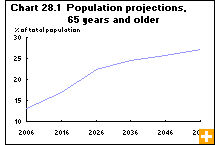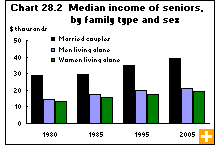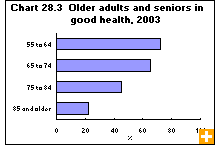Common menu bar links
Seniors
Archived Content
Information identified as archived is provided for reference, research or recordkeeping purposes. It is not subject to the Government of Canada Web Standards and has not been altered or updated since it was archived. Please contact us to request a format other than those available.
Like most industrialized countries, Canada is seeing an increase in its senior population. In recent decades, the Canadian population aged 65 and older has grown—it totalled 4.3 million in 2006.
Seniors comprised 13% of Canada’s population in 2006, compared with 10% in 1981 and only 5% in 1921. By 2056, the share of the population aged 65 and older may reach 27%. Women are the majority among seniors—56% of persons aged 65 and older and 64% of those 80 and older in 2006.
The most rapid growth is in the older age groups. In 2006, 3.6% of the population was aged 80 and older—this figure could reach 10% by 2056.
The percentage of seniors varies greatly from one census metropolitan area to another. In 2006, St. Catharines–Niagara and Victoria had the largest shares, followed by Trois-Rivières and Thunder Bay. Proportionally fewer seniors live in Calgary, St. John’s, Oshawa, Edmonton and Ottawa–Gatineau. From 1986 to 2004, the share of seniors grew the most in Saguenay, Trois-Rivières and Greater Sudbury.
Family status
In 2001, 93% of seniors lived in private households and 7% in collective dwellings—primarily health care institutions such as nursing homes and hospitals. The proportion of seniors living in an institution ranged between 2% for those aged 65 to 74 and 32% for those aged 85 and older.
In all age groups, a larger proportion of seniors lived with a spouse in 2001 than in 1981: 54% of seniors aged 65 to 74 lived with a spouse, up from 51% in 1981. The gap in life expectancy between men and women has narrowed since the late 1970s.
In 2001, most seniors living with their spouse had marriage as their form of union, since most had gotten together when legal marriage was the only socially acceptable option. Thus, only 2% of seniors lived common-law in 2001, compared with 14% of couples aged 25 to 54.
The share of seniors aged 85 and older who live alone has changed dramatically: 22% of them lived alone in 1981, compared with 34% in 2001. The share of seniors aged 65 to 74 living alone has remained stable at 22%.
Senior women were twice as likely as senior men to live alone in 2001. Women’s longer life expectancy helps explain this, as does men’s tendency to marry younger women. Since women enjoy a greater probability of outliving their spouse, they are more likely to be living alone late in life.
Financial status
Canadian seniors’ financial status has improved significantly over the last 25 years. The median after-tax income of elderly married couples in 2005 dollars rose from $29,000 in 1980 to $38,900 in 2005, an increase of 34%. Across the provinces, their median after-tax income ranged from $28,700 in Newfoundland and Labrador to $44,100 in Ontario. The incomes of seniors not living with family members rose by even higher percentages in this period.
Greater access to the Canada and Quebec pension plans has done much to improve seniors’ financial status, as has the expanded coverage of private employer-sponsored pension plans. Also, a greater proportion of seniors are now eligible to collect benefits from the Canada and Quebec pension plans. This has helped substantially lower the percentage of seniors in low income—in 2005, that percentage was lower in Canada than in most industrialized countries. This is a marked change from the 1970s, when the percentage of low income seniors in Canada was among the highest of the industrialized countries.
Seniors are now getting a smaller proportion of their total income from government transfers such as Old Age Security benefits, the Guaranteed Income Supplement and the Spouse’s Allowance than in the early 1980s. Still, 97% of seniors received income from one or more of these sources in 2005, and these sources accounted for 32% of senior women’s income.
From 1980 to 1992, the share of men aged 65 and older with employment earnings dropped from 24% to 13%. By 2005, it had rebounded to 24%.
Health status
During the twentieth century, life expectancy at 65 in Canada increased dramatically. In 1901, a 65-year-old could expect to live an additional 11 years; by 2001, this had increased to 19 years.
Cancer and heart disease are the leading causes of death for those 65 and older, followed by stroke and respiratory diseases. According to a study of factors associated with death in seniors over an eight-year period, psychological distress strongly predicted death in women, as did widowhood in men.
Arthritis (or rheumatism) and high blood pressure were the chronic health conditions most often reported by seniors in 2005, especially women. The frequency of these two chronic conditions may rise in the future, since obesity—a factor closely linked to the probability of developing each of these disorders—has been rising in recent years.
Nevertheless, many seniors still fare very well, even though aging tends to be associated with a decline in general health and the onset of various activity limitations. In the 2003 Canadian Community Health Survey (CCHS), more than 7 seniors in 10 had good functional health, were independent in the activities of daily living and had a positive perception of their general health.
However, the proportion of seniors in good functional health declines sharply with age. In 2003, 80% of seniors aged 65 to 74 either had no disabilities or had fully-corrected disabilities (wearing glasses, for example). This was true of only 37% of seniors aged 85 and older. Declines by age are steepest for mobility and cognition.
The 2003 CCHS data showed that exercising occasionally or frequently, drinking moderately, eating fruit and vegetables often, having a normal body weight, having low stress levels and feeling connected to the community all play an important role in seniors’ overall health. An eight-year follow-up of seniors surveyed in 1994/1995 showed that avoiding smoking, obesity, inactivity and heavy drinking helped seniors to stay healthy and increased their chances of recovering after an illness.





